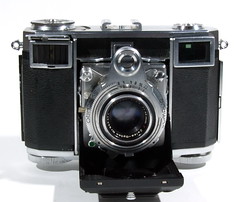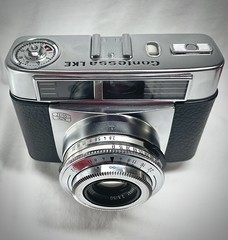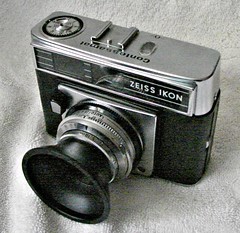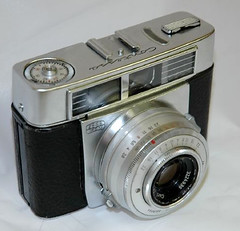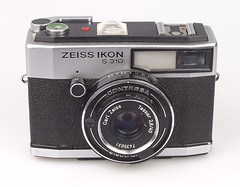Difference between revisions of "Contessa 35"
m (correcting Collection Appareils link) |
m (→Folding Contessa) |
||
| (70 intermediate revisions by 5 users not shown) | |||
| Line 1: | Line 1: | ||
| − | |||
| − | |||
| − | |||
| − | |||
| − | |||
| − | |||
| − | |||
{{Flickr_image | {{Flickr_image | ||
|image_source= http://www.flickr.com/photos/ja1vbn/44633566/in/pool-camerawiki/ | |image_source= http://www.flickr.com/photos/ja1vbn/44633566/in/pool-camerawiki/ | ||
| − | |image= http://static.flickr.com/31/ | + | |image= http://static.flickr.com/31/44633566_76c773b9de_n.jpg |
| − | |image_align= | + | |image_align= right |
| − | |image_text= Contessa 35 | + | |image_text= Contessa 35 533/24<br>Second version of this classic folder |
|image_by=ja1vbn | |image_by=ja1vbn | ||
|image_rights=with permission | |image_rights=with permission | ||
}} | }} | ||
| − | + | '''Contessa''' was the name given to a family of [[35mm]] film cameras produced by [[Zeiss Ikon]] in Stuttgart between 1950-1955 (folding) and 1960-1971 (non-folding), the name is a reference to the '''[[Contessa-Nettel]]''' factory. | |
| − | The | + | These were mid to high-end [[rangefinder camera|rangefinder]]/[[viewfinder camera|viewfinder]] cameras with fixed lens. The lens was a Tessar 45/2.8 or 50/2.8 lens which produced very good pictures for the time. |
| − | + | ||
| + | The original name for the Contessa's camera design was 522/24 [[Contina| Ikonta 35]] which was then changed to 533/24, with the old designation going to the [[Contina]] for the lower-end cameras in 1954. | ||
| + | |||
| + | == Folding Contessa == | ||
| + | |||
| + | The '''Contessa 35''' was the 3rd camera designed by [[Hubert Nerwin]], as part of the effort to rebuild the Zeiss Ikon name after WWII. The Contessa was produced between 1950-1955 and it was a high end [[35mm]] [[folding]] [[rangefinder camera|rangefinder]] camera with catalog number 533/24, with the Ikonta 35 and Contina as lower end cameras. All these models followed Nerwins' simmetrical camera design and the Contessa added elements from the [[Super Ikonta]]'s design with the characteristic extra lens for the coupled rangefinder. | ||
| − | + | Zeiss Ikon took every detail into account for design and built, highly over-engineered by today's standard, inside and outside of the camera. It is not only the outside appearance, with lots of chrome used, hidden tripod bushing in the front door, a small foot that keeps the camera leveled when placed on a table, and a solid feel, but also the image quality, and the balance of the camera in the hands. | |
| − | {| | + | The Contessas were fitted with the 45mm/2.8 Zeiss-Opton[[Tessar]], with a 9 blade diaphragm closing to f/22. The choice of 45mm over 50mm was a move by Zeiss to provide the user with extra depth of field. [[Tessar]] lenses are great performers even by today's standards, especially those marked Opton T* lenses which were coated, while uncoated lenses work best with a lens shade. These lenses are marked Zeiss-Opton because the West German part of the business couldn't use the name Carl Zeiss. This camera takes 28.5mm push filters and lens-shade (Zeiss Ikon 20.0700 / 1110 A) or 27mm (S27) filters mounted on the female side.<ref>[https://web.archive.org/web/20160314121146/http://www.zeisshistorica.org/Nerwin%20cameras.html Nerwin Cameras by Zeiss Historical] </ref> |
| + | |||
| + | Rangefinder is coupled and has a base of 42mm, giving good precision for shooting at f/2.8 but better at f/8. Zeiss used a prism instead of a mirror, which has made them very long lasting. For today's standards the viewfinder is small but the RF patch is bright and easy to use. | ||
| + | |||
| + | Lightmeter is an uncoupled [[selenium meter]] placed on the corner of the camera, which has a dual range, depending if it is used with the gate opened (black scale) or closed (green scale). The Selenium cell covered a relatively wide range of [[Exposure value| EV]]s (Bright EV 10-17, Dim EV 3-10 @ISO 100). These lightmeters are simple, and rarely fail. | ||
| + | |||
| + | Shutters were either a Compur Rapid or a Synchro Compur, depending on the year of production. The shutter release is on the front and the shutter must be cocked manually, which is a solution that was phased out shortly after the launch of these cameras. A double exposure prevention is present, driven by the film sprocket cogs inside the camera. Film wind and rewind is done via wheels at the bottom of the camera, the film counter must be set manually to S when loading. There is a cable release, which is located at the bottom left of the shutter (7 o'clock) in the Compur-Rapid, and top-right (1 o'clock positon) in the Synchro-Compur camera, this change of location was made to give space to the M-X switch in the Synchro-Compur. | ||
| + | |||
| + | There were 2 iterations of this camera with several submodels. The Serial number database published by Zeiss Historica shown that about 185,000 cameras were made.<ref>[https://mikeeckman.com/2019/11/zeiss-historica-fall-2010/ Zeiss Historica Magazine Fall 2010 page 7] At Mike Eckman photography pages</ref> | ||
| + | |||
| + | {| class="wikitable" | ||
|+ Folding Contessa cameras | |+ Folding Contessa cameras | ||
! Zeiss Nbr !! Model !! Years !! Lens !! Shutter !! Notes | ! Zeiss Nbr !! Model !! Years !! Lens !! Shutter !! Notes | ||
|- | |- | ||
| − | + | |533/24 || 35 || 1949-1953 || f2.8 45mm Tessar || Compur Rapid <br> B-1-2-5-10-25-50-100-250-500 ||X synch <br> cable release at bottom left corner (7 o'clock) | |
|- | |- | ||
| − | + | |533/24 || 35 || 1951-1955 || f2.8 45mm Tessar || Synchro Compur <br> B-1-2-5-10-25-50-100-250-500 ||MX synch,(some models have selftimer V) at botton left corner <br> cable release top right corner (1 o'clock) | |
|- | |- | ||
|} | |} | ||
| + | |||
| + | {|class=wikitable | ||
| + | |{{Flickr_image | ||
| + | |image_source= https://www.flickr.com/photos/titrisol/53515722220/in/pool-camerawiki | ||
| + | |image=https://live.staticflickr.com/65535/53515722220_3866156362_m.jpg | ||
| + | |image_align= | ||
| + | |image_text= Top View | ||
| + | |image_by= | ||
| + | |image_rights= with permission | ||
| + | }} | ||
| + | |{{Flickr_image | ||
| + | |image_source=https://www.flickr.com/photos/titrisol/53515418195/in/pool-camerawiki | ||
| + | |image= https://live.staticflickr.com/65535/53515418195_d9e02d701e_m.jpg | ||
| + | |image_align= | ||
| + | |image_text= Side view | ||
| + | |image_by= | ||
| + | |image_rights= with permission | ||
| + | }} | ||
| + | |{{Flickr_image | ||
| + | |image_source= https://www.flickr.com/photos/titrisol/53515304019/in/pool-camerawiki/ | ||
| + | |image= https://live.staticflickr.com/65535/53515304019_2b0cf68c82_m.jpg | ||
| + | |image_align= | ||
| + | |image_text= Front view | ||
| + | |image_by= | ||
| + | |image_rights= with permission | ||
| + | }} | ||
| + | |- | ||
| + | |colspan=3 align=center | '''1st version Contessa 35 (533/24)''' <br>Compur Rapid shutter; Cable release in the 7 o'clock position <br> {{image author|Pablo Coronel}} {{ with permission }} | ||
| + | |- | ||
| + | |{{Flickr_image | ||
| + | |image_source= https://www.flickr.com/photos/s-demir/5425314060/in/pool-camerawiki | ||
| + | |image= https://live.staticflickr.com/5217/5425314060_b05ffddb4f_m.jpg | ||
| + | |image_align= Left | ||
| + | |image_text= Top View | ||
| + | |image_by= | ||
| + | |image_rights= with permission | ||
| + | }} | ||
| + | |{{Flickr_image | ||
| + | |image_source=https://www.flickr.com/photos/s-demir/5424709477/in/pool-camerawiki | ||
| + | |image= https://live.staticflickr.com/5173/5424709477_9e221b918f_m.jpg | ||
| + | |image_align= Left | ||
| + | |image_text= Side view | ||
| + | |image_by= | ||
| + | |image_rights= with permission | ||
| + | }} | ||
| + | |{{Flickr_image | ||
| + | |image_source= https://www.flickr.com/photos/s-demir/5424708669/in/pool-camerawiki | ||
| + | |image= https://live.staticflickr.com/5260/5424708669_8245683d3b_m.jpg | ||
| + | |image_align= Left | ||
| + | |image_text= Front view | ||
| + | |image_by= | ||
| + | |image_rights= with permission | ||
| + | }} | ||
| + | |- | ||
| + | |colspan=3 align=center | '''2nd version Contessa 35 (533/24)''' <br> Synchro Compur shutter with M-X settings; Cable release in the 1 o'clock position <br> {{image author|Süleyman Demir}} {{ with permission }} | ||
| + | |} | ||
| + | |||
| + | |||
| + | {{br}} | ||
==The non-folding Contessas== | ==The non-folding Contessas== | ||
| − | + | {|class="floatright" style="text-align:center;" | |
| + | || | ||
| + | {{Flickr_image | ||
| + | |image_source= https://flic.kr/p/2kxinJJ | ||
| + | |image= https://live.staticflickr.com/65535/50893672538_6c676d30cd_m.jpg | ||
| + | |image_align= | ||
| + | |image_text= Zeiss Ikon Contessa (10.0632) | ||
| + | |image_by= Christoph Batz | ||
| + | |image_rights= cc | ||
| + | }} | ||
| + | |- | ||
| + | || | ||
{{Flickr_image | {{Flickr_image | ||
|image_source= http://www.flickr.com/photos/89853469@N00/820411106/in/pool-camerawiki/ | |image_source= http://www.flickr.com/photos/89853469@N00/820411106/in/pool-camerawiki/ | ||
|image= http://farm2.static.flickr.com/1148/820411106_c6f52f9201_m.jpg | |image= http://farm2.static.flickr.com/1148/820411106_c6f52f9201_m.jpg | ||
| − | |image_align= | + | |image_align= |
|image_text= Zeiss Ikon Contessa LK | |image_text= Zeiss Ikon Contessa LK | ||
| − | |image_by= titrisol | + | |image_by= Pablo Coronel |
| + | |image_rights= with permission | ||
| + | }} | ||
| + | |- | ||
| + | || | ||
| + | {{Flickr_image | ||
| + | |image_source= https://www.flickr.com/photos/titrisol/51546553794/in/pool-camerawiki/ | ||
| + | |image= https://live.staticflickr.com/65535/51546553794_120cee50a0_m.jpg | ||
| + | |image_align= | ||
| + | |image_text= Zeiss Ikon Contessa LKE | ||
| + | |image_by= Pablo Coronel | ||
| + | |image_rights= with permission | ||
| + | }} | ||
| + | |- | ||
| + | || | ||
| + | {{Flickr_image | ||
| + | |image_source=https://www.flickr.com/photos/s-demir/4507512940/in/pool-camerawiki/ | ||
| + | |image= https://live.staticflickr.com/4067/4507512940_709f97ca14_m.jpg | ||
| + | |image_align= | ||
| + | |image_text= Zeiss Ikon Contessa LBE <br> Hot shoe for flash | ||
| + | |image_by= Süleyman Demir | ||
|image_rights= with permission | |image_rights= with permission | ||
}} | }} | ||
| − | + | |- | |
| − | + | || | |
| − | |||
{{Flickr_image | {{Flickr_image | ||
|image_source= http://www.flickr.com/photos/n6nkn/146324742/in/pool-camerawiki | |image_source= http://www.flickr.com/photos/n6nkn/146324742/in/pool-camerawiki | ||
|image= http://farm1.static.flickr.com/50/146324742_921d596fc7_m.jpg | |image= http://farm1.static.flickr.com/50/146324742_921d596fc7_m.jpg | ||
| − | |image_align= | + | |image_align= |
|image_text= Zeiss Ikon Contessamat | |image_text= Zeiss Ikon Contessamat | ||
|image_by=Rick Zolla | |image_by=Rick Zolla | ||
|image_rights=with permission | |image_rights=with permission | ||
}} | }} | ||
| + | |- | ||
| + | || | ||
{{Flickr_image | {{Flickr_image | ||
|image_source= http://www.flickr.com/photos/89853469@N00/740148963/in/pool-camerawiki | |image_source= http://www.flickr.com/photos/89853469@N00/740148963/in/pool-camerawiki | ||
| − | |image= | + | |image=https://live.staticflickr.com/65535/740148963_de62bd1c0d_m.jpg |
| − | |image_align= | + | |image_align= |
|image_text= Zeiss Ikon Contessamatic | |image_text= Zeiss Ikon Contessamatic | ||
| − | |image_by= | + | |image_by= Pablo Coronel |
|image_rights= with permission | |image_rights= with permission | ||
}} | }} | ||
| − | In the mid-60s the Contessamat line came in production, these cameras had a [[shutter priority| speed priority]] system that allowed for an AUTO operation. | + | |- |
| + | || | ||
| + | {{Flickr_image | ||
| + | |image_source= https://flic.kr/p/2kpFXP6 | ||
| + | |image= https://live.staticflickr.com/65535/50807547663_a5a3ac7466_m.jpg | ||
| + | |image_align= | ||
| + | |image_text= Zeiss Ikon Contessa S310 | ||
| + | |image_by= Christoph Batz | ||
| + | |image_rights= cc | ||
| + | }} | ||
| + | |} | ||
| + | Between 1960-1970 the name '''Contessa''' was used again for a family of fixed lens non-folding cameras that included Contessa, Contessamatic and Contessamat. Initially the same name and catalog number as the folding camera was used, but later it was changed to a new catalog number. | ||
| + | |||
| + | The models showed the evolution in design, internal and external, with the letter E (entfernungsmesser) added to the name of the cameras to indicate the presence of a [[rangefinder (device)| rangefinder]]. The Contessamatic E uses whole unit focusing and the LKE/LBE uses front focusing. | ||
| + | These cameras are of a modern design, with rapid film advance, coupled lightmeter and very informative viewfinders. | ||
| + | Initially, they came with a Tessar 50/2.8 lens and lightmeter coupled with the shutter which is of the [[Prontor]] family. | ||
| + | |||
| + | In the mid-60s the [[Contessamat]] line came in production, these cameras had a [[shutter priority| speed priority]] system that allowed for an AUTO operation. The viewfinder showed the aperture and red marks for over/under exposure. | ||
The lens was a Color-Pantar 45/2.8 or a Tessar 50/2.8 | The lens was a Color-Pantar 45/2.8 or a Tessar 50/2.8 | ||
| + | These cameras take 27mm screw on filters and and 28.5 push on filters. A rubber collapsible lens shade was available (Zeiss Ikon 1109) | ||
| − | {| | + | {| class="wikitable" |
|+ List of Non-Folding Contessa cameras | |+ List of Non-Folding Contessa cameras | ||
! Zeiss Nbr !! Model !! Years !! Lens !! Shutter !! Notes | ! Zeiss Nbr !! Model !! Years !! Lens !! Shutter !! Notes | ||
|- | |- | ||
| − | + | | 533/24 || 35 || 1960-1961 || f2.8 50mm Tessar || Prontor || rangefinder | |
|- | |- | ||
| − | + | |10.0632 || Contessa || 1960-1961 || f2.8 50mm Tessar || Pronto || viewfinder, low budget model<ref>[https://www.pacificrimcamera.com/rl/00075/00075.pdf Zeiss Ikon Trade News] on [https://www.pacificrimcamera.com Pacific Rim Camera]</ref> | |
|- | |- | ||
| − | + | |10.0637 || LK || 1963-1965 || f2.8 50mm Tessar || Prontor 500 LK (B,15-500) || viewfinder <br> late models have hot shoe<ref>[https://flic.kr/p/nkBq4Q Contessa LK with Hotshoe] Photo by Gilles Péris y Saborit</ref> | |
|- | |- | ||
| − | + | |10.0638 || LKE || 1963-1965 ||f2.8 50mm Tessar ||Prontor 500 LK (B,15-500) ||similar to LK but with rangefinder <br> late models have shot shoe | |
|- | |- | ||
| − | + | |10.0639 || LBE || 1965-1967 || f2.8 50mm Tessar || Prontor 500 LK || range finder and flash aperture settings <br> hot shoe for flash | |
|- | |- | ||
| − | + | |10.0634 || Contessamatic ||1960-1961 ||f2.8 50mm Tessar ||Prontor SLK (B,15-500) or Pr SLK Spezial (B,1-500) ||viewfinder <br> lightmeter reading in viewfinder | |
|- | |- | ||
| − | + | |10.0645|| Contessamatic E|| 1960-1963|| f2.8 50mm Tessar|| Pr SLK Spezial (B,1-500)|| range finder <br> whole unit focusing<br>lightmeter reading in viewfinder | |
|- | |- | ||
| − | + | | ||Contessamat ||1964-1965 ||f2.8 45mm Color Pantar ||Prontormatic|| viewfinder | |
|- | |- | ||
| − | + | |10.0652 ||Contessamat SBE ||1963-1967 ||f2.8 50mm Tessar ||Prontormatic 500SL (B,15-500) ||rangefinder | |
|- | |- | ||
| − | + | |10.0654 ||Contessamat SE ||1963-1965 ||f2.8 45mm Color Pantar|| Prontormatic 500 || rangefinder | |
|- | |- | ||
| − | + | | 10.0656|| Contessamat STE || 1965 ||f2.8 50mm Tessar ||Prontormatic 500SL || rangefinder | |
|- | |- | ||
| − | + | |10.0351 ||S-310 ||1971 ||f2.8 40mm Tessar || Prontor 500 S|| viewfinder | |
| + | |- | ||
| + | |10.0354 ||S-312 ||1971 ||f2.8 40mm Tessar || Prontor 500 S || similar to S-310 but with rangefinder | ||
|- | |- | ||
|} | |} | ||
| − | At the end of the life of the West German Zeiss Ikon company, two very innovative cameras branding | + | At the end of the life of the West German Zeiss Ikon company, two very innovative cameras branding the name Contessa came to life, S310 and S312. These cameras were developed by [[Voigtländer]] and after the merger of the two companies came to the market under the Contessa S-31x and the [[Voigtländer VF 101]] name simultaneously. Auto exposure control made them ideal for the new point-and-shoot market in the 1970s. |
==References== | ==References== | ||
| − | * [http://www.wctatel.net/web/crye/z-i35mm.htm | + | * [https://web.archive.org/web/20140702061617/http://www.wctatel.net/web/crye/z-i35mm.htm Model List of all Zeiss Ikon 35mm cameras by Clayton Rye] (archived) |
| − | * [http://www.netcontax.com/time_machines.htm Something Zeiss to say] | + | * [https://web.archive.org/web/20090311042622/http://www.netcontax.com/time_machines.htm Something Zeiss to say] (archived) A website about classic Zeiss Cameras by Greg Bedore |
| − | * [http://www.cameraquest.com/contessa.htm Stephen Gandy's Notes on the Contessa 35] | + | * [http://www.cameraquest.com/contessa.htm Stephen Gandy's Notes on the Contessa 35] at Cameraquest website |
| − | * [http://www.zeisshistorica.org/Nerwin.html Hubert Nerwin at the Zeiss Historical Society] | + | * [https://web.archive.org/web/20160411192330/http://www.zeisshistorica.org/Nerwin.html Hubert Nerwin at the Zeiss Historical Society] (archived) |
| − | [ | + | * [https://www.mikeeckman.com/photovintage/vintagecameras/contessa35/index.html Contessa 35] by Mike Eckman |
| − | [ | + | * [https://web.archive.org/web/20160314121146/http://www.zeisshistorica.org/Nerwin%20cameras.html Nerwin Cameras] at Zeiss Historica Society in the Wayback machine |
| − | + | ||
| + | ==Notes== | ||
| + | <references/> | ||
==Links== | ==Links== | ||
| − | at [http://www.collection-appareils.fr/general/html/francais.php www.collection-appareils.com] by Sylvain Halgand | + | *[https://www.butkus.org/chinon/zeiss_ikon/zeiss_ikon_contessa/zeiss_ikon_contessa.htm Zeiss Ikon Contessa user manual] at [https://www.butkus.org/chinon/ Butkus.org] |
| + | *[https://www.butkus.org/chinon/zeiss_ikon/zeiss_ikon_contessa_lke/zeiss_ikon_contessa_lke.htm Zeiss Ikon Contessa LKE user manual] at [https://www.butkus.org/chinon/ Butkus.org] | ||
| + | *[https://www.butkus.org/chinon/zeiss_ikon/zeiss_ikon_contessamatic/zeiss_ikon_contessamatic.htm Zeiss Ikon Contessamatic user manual] at [https://www.butkus.org/chinon/ Butkus.org] | ||
| + | *[https://www.butkus.org/chinon/zeiss_ikon/zeiss_ikon_contessamat/zeiss_icon_contessamat.htm Zeiss Ikon Contessamat user manual] at [https://www.butkus.org/chinon/ Butkus.org] | ||
| + | *[https://www.butkus.org/chinon/zeiss_ikon/zeiss_ikon_contessamat_se/zeiss_ikon_contessamat_se.htm Zeiss Ikon Contessamat SE user manual] at [https://www.butkus.org/chinon/ Butkus.org] | ||
| + | * [http://elekm.net/pages/cameras/contessa.htm folding Contessa] at [http://elekm.net/pages/ Mike Eleks Cameras & Stuff] | ||
| + | * [http://elekm.net/zeiss-ikon/repair/meter-repair/ selenium meter repair] at [http://elekm.net/pages/ Mike Eleks Cameras & Stuff] | ||
| + | * [https://www.pacificrimcamera.com/pp/zicontessash.htm Zeiss Ikon Contessa Pages] at Pacific Rim Camera | ||
| + | </br> | ||
| + | at [http://www.collection-appareils.fr/general/html/francais.php www.collection-appareils.com] by Sylvain Halgand (in French) | ||
* [http://www.collection-appareils.fr/x/html/page_standard.php?id_appareil=1579 Zeiss Ikon Contessa 35] and [http://www.collection-appareils.fr/x/html/page_standard.php?id_appareil=12066 Zeiss Ikon Contessa 35 version 2] | * [http://www.collection-appareils.fr/x/html/page_standard.php?id_appareil=1579 Zeiss Ikon Contessa 35] and [http://www.collection-appareils.fr/x/html/page_standard.php?id_appareil=12066 Zeiss Ikon Contessa 35 version 2] | ||
| + | * [https://www.cameraquest.com/contessa.htm Contessa 35 by Stephen Gandy] at [https://www.cameraquest.com/ cameraquest] | ||
* [http://www.collection-appareils.fr/x/html/page_standard.php?id_appareil=12067 Contessa] | * [http://www.collection-appareils.fr/x/html/page_standard.php?id_appareil=12067 Contessa] | ||
| − | * [http://www.collection-appareils.fr/ | + | * [http://www.collection-appareils.fr/x/html/page_standard.php?id_appareil=1545 Contessa LKE] |
| − | * [http://www.collection-appareils.fr/ | + | * [http://www.collection-appareils.fr/x/html/page_standard.php?id_appareil=12065 Contessa S310] |
| − | + | ||
| − | + | [[Category:Zeiss Ikon AG]] | |
| + | [[Category:German 35mm rangefinder]] | ||
| + | [[Category:C]] | ||
| + | [[Category: 1950-1959]] | ||
| + | [[Category: 1960-1969]] | ||
Latest revision as of 13:50, 13 February 2024
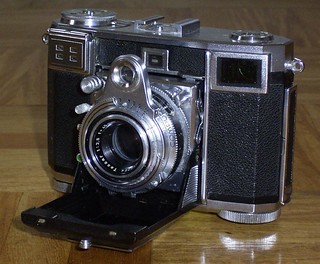
|
| Contessa 35 533/24 Second version of this classic folder image by ja1vbn (Image rights) |
Contessa was the name given to a family of 35mm film cameras produced by Zeiss Ikon in Stuttgart between 1950-1955 (folding) and 1960-1971 (non-folding), the name is a reference to the Contessa-Nettel factory. These were mid to high-end rangefinder/viewfinder cameras with fixed lens. The lens was a Tessar 45/2.8 or 50/2.8 lens which produced very good pictures for the time.
The original name for the Contessa's camera design was 522/24 Ikonta 35 which was then changed to 533/24, with the old designation going to the Contina for the lower-end cameras in 1954.
Folding Contessa
The Contessa 35 was the 3rd camera designed by Hubert Nerwin, as part of the effort to rebuild the Zeiss Ikon name after WWII. The Contessa was produced between 1950-1955 and it was a high end 35mm folding rangefinder camera with catalog number 533/24, with the Ikonta 35 and Contina as lower end cameras. All these models followed Nerwins' simmetrical camera design and the Contessa added elements from the Super Ikonta's design with the characteristic extra lens for the coupled rangefinder.
Zeiss Ikon took every detail into account for design and built, highly over-engineered by today's standard, inside and outside of the camera. It is not only the outside appearance, with lots of chrome used, hidden tripod bushing in the front door, a small foot that keeps the camera leveled when placed on a table, and a solid feel, but also the image quality, and the balance of the camera in the hands.
The Contessas were fitted with the 45mm/2.8 Zeiss-OptonTessar, with a 9 blade diaphragm closing to f/22. The choice of 45mm over 50mm was a move by Zeiss to provide the user with extra depth of field. Tessar lenses are great performers even by today's standards, especially those marked Opton T* lenses which were coated, while uncoated lenses work best with a lens shade. These lenses are marked Zeiss-Opton because the West German part of the business couldn't use the name Carl Zeiss. This camera takes 28.5mm push filters and lens-shade (Zeiss Ikon 20.0700 / 1110 A) or 27mm (S27) filters mounted on the female side.[1]
Rangefinder is coupled and has a base of 42mm, giving good precision for shooting at f/2.8 but better at f/8. Zeiss used a prism instead of a mirror, which has made them very long lasting. For today's standards the viewfinder is small but the RF patch is bright and easy to use.
Lightmeter is an uncoupled selenium meter placed on the corner of the camera, which has a dual range, depending if it is used with the gate opened (black scale) or closed (green scale). The Selenium cell covered a relatively wide range of EVs (Bright EV 10-17, Dim EV 3-10 @ISO 100). These lightmeters are simple, and rarely fail.
Shutters were either a Compur Rapid or a Synchro Compur, depending on the year of production. The shutter release is on the front and the shutter must be cocked manually, which is a solution that was phased out shortly after the launch of these cameras. A double exposure prevention is present, driven by the film sprocket cogs inside the camera. Film wind and rewind is done via wheels at the bottom of the camera, the film counter must be set manually to S when loading. There is a cable release, which is located at the bottom left of the shutter (7 o'clock) in the Compur-Rapid, and top-right (1 o'clock positon) in the Synchro-Compur camera, this change of location was made to give space to the M-X switch in the Synchro-Compur.
There were 2 iterations of this camera with several submodels. The Serial number database published by Zeiss Historica shown that about 185,000 cameras were made.[2]
| Zeiss Nbr | Model | Years | Lens | Shutter | Notes |
|---|---|---|---|---|---|
| 533/24 | 35 | 1949-1953 | f2.8 45mm Tessar | Compur Rapid B-1-2-5-10-25-50-100-250-500 |
X synch cable release at bottom left corner (7 o'clock) |
| 533/24 | 35 | 1951-1955 | f2.8 45mm Tessar | Synchro Compur B-1-2-5-10-25-50-100-250-500 |
MX synch,(some models have selftimer V) at botton left corner cable release top right corner (1 o'clock) |
|
|
| ||||||
| 1st version Contessa 35 (533/24) Compur Rapid shutter; Cable release in the 7 o'clock position Pablo Coronel (Image rights) | ||||||||
|
|
| ||||||
| 2nd version Contessa 35 (533/24) Synchro Compur shutter with M-X settings; Cable release in the 1 o'clock position Süleyman Demir (Image rights) | ||||||||
The non-folding Contessas
| ||
| ||
| ||
| ||
| ||
| ||
|
Between 1960-1970 the name Contessa was used again for a family of fixed lens non-folding cameras that included Contessa, Contessamatic and Contessamat. Initially the same name and catalog number as the folding camera was used, but later it was changed to a new catalog number.
The models showed the evolution in design, internal and external, with the letter E (entfernungsmesser) added to the name of the cameras to indicate the presence of a rangefinder. The Contessamatic E uses whole unit focusing and the LKE/LBE uses front focusing. These cameras are of a modern design, with rapid film advance, coupled lightmeter and very informative viewfinders. Initially, they came with a Tessar 50/2.8 lens and lightmeter coupled with the shutter which is of the Prontor family.
In the mid-60s the Contessamat line came in production, these cameras had a speed priority system that allowed for an AUTO operation. The viewfinder showed the aperture and red marks for over/under exposure. The lens was a Color-Pantar 45/2.8 or a Tessar 50/2.8
These cameras take 27mm screw on filters and and 28.5 push on filters. A rubber collapsible lens shade was available (Zeiss Ikon 1109)
| Zeiss Nbr | Model | Years | Lens | Shutter | Notes |
|---|---|---|---|---|---|
| 533/24 | 35 | 1960-1961 | f2.8 50mm Tessar | Prontor | rangefinder |
| 10.0632 | Contessa | 1960-1961 | f2.8 50mm Tessar | Pronto | viewfinder, low budget model[3] |
| 10.0637 | LK | 1963-1965 | f2.8 50mm Tessar | Prontor 500 LK (B,15-500) | viewfinder late models have hot shoe[4] |
| 10.0638 | LKE | 1963-1965 | f2.8 50mm Tessar | Prontor 500 LK (B,15-500) | similar to LK but with rangefinder late models have shot shoe |
| 10.0639 | LBE | 1965-1967 | f2.8 50mm Tessar | Prontor 500 LK | range finder and flash aperture settings hot shoe for flash |
| 10.0634 | Contessamatic | 1960-1961 | f2.8 50mm Tessar | Prontor SLK (B,15-500) or Pr SLK Spezial (B,1-500) | viewfinder lightmeter reading in viewfinder |
| 10.0645 | Contessamatic E | 1960-1963 | f2.8 50mm Tessar | Pr SLK Spezial (B,1-500) | range finder whole unit focusing lightmeter reading in viewfinder |
| Contessamat | 1964-1965 | f2.8 45mm Color Pantar | Prontormatic | viewfinder | |
| 10.0652 | Contessamat SBE | 1963-1967 | f2.8 50mm Tessar | Prontormatic 500SL (B,15-500) | rangefinder |
| 10.0654 | Contessamat SE | 1963-1965 | f2.8 45mm Color Pantar | Prontormatic 500 | rangefinder |
| 10.0656 | Contessamat STE | 1965 | f2.8 50mm Tessar | Prontormatic 500SL | rangefinder |
| 10.0351 | S-310 | 1971 | f2.8 40mm Tessar | Prontor 500 S | viewfinder |
| 10.0354 | S-312 | 1971 | f2.8 40mm Tessar | Prontor 500 S | similar to S-310 but with rangefinder |
At the end of the life of the West German Zeiss Ikon company, two very innovative cameras branding the name Contessa came to life, S310 and S312. These cameras were developed by Voigtländer and after the merger of the two companies came to the market under the Contessa S-31x and the Voigtländer VF 101 name simultaneously. Auto exposure control made them ideal for the new point-and-shoot market in the 1970s.
References
- Model List of all Zeiss Ikon 35mm cameras by Clayton Rye (archived)
- Something Zeiss to say (archived) A website about classic Zeiss Cameras by Greg Bedore
- Stephen Gandy's Notes on the Contessa 35 at Cameraquest website
- Hubert Nerwin at the Zeiss Historical Society (archived)
- Contessa 35 by Mike Eckman
- Nerwin Cameras at Zeiss Historica Society in the Wayback machine
Notes
- ↑ Nerwin Cameras by Zeiss Historical
- ↑ Zeiss Historica Magazine Fall 2010 page 7 At Mike Eckman photography pages
- ↑ Zeiss Ikon Trade News on Pacific Rim Camera
- ↑ Contessa LK with Hotshoe Photo by Gilles Péris y Saborit
Links
- Zeiss Ikon Contessa user manual at Butkus.org
- Zeiss Ikon Contessa LKE user manual at Butkus.org
- Zeiss Ikon Contessamatic user manual at Butkus.org
- Zeiss Ikon Contessamat user manual at Butkus.org
- Zeiss Ikon Contessamat SE user manual at Butkus.org
- folding Contessa at Mike Eleks Cameras & Stuff
- selenium meter repair at Mike Eleks Cameras & Stuff
- Zeiss Ikon Contessa Pages at Pacific Rim Camera
at www.collection-appareils.com by Sylvain Halgand (in French)





